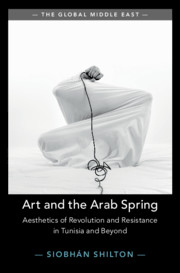Book contents
- Art and the Arab Spring
- The Global Middle East
- Art and the Arab Spring
- Copyright page
- Contents
- Figures
- Acknowledgements
- Introduction
- 1 Aesthetics of Revolution and Infra-thin Critique
- 2 Contingency and Resistance: Exceeding Icons through Matter and Motion
- 3 Contingent Encounters: Artists, Artisans and Amateurs
- 4 Corporeal Resistance and Aesthetics of the Interface
- Conclusion
- References
- Index
Conclusion
Art and Revolution: Aesthetics and Approaches
Published online by Cambridge University Press: 07 July 2021
- Art and the Arab Spring
- The Global Middle East
- Art and the Arab Spring
- Copyright page
- Contents
- Figures
- Acknowledgements
- Introduction
- 1 Aesthetics of Revolution and Infra-thin Critique
- 2 Contingency and Resistance: Exceeding Icons through Matter and Motion
- 3 Contingent Encounters: Artists, Artisans and Amateurs
- 4 Corporeal Resistance and Aesthetics of the Interface
- Conclusion
- References
- Index
Summary
A wide-ranging corpus of art exploring revolutions in countries from Tunisia to Syria moves beyond what Jellel Gasteli dubbed ‘icons of revolutionary exoticism’. This art forges a way between the essentialising internal and external visions perpetuated by iconic or iconoclastic images, encouraging a more nuanced understanding of the revolutions. It also enables spectators to develop a greater consciousness – mediated through their senses as well as through their intellect – of the meaning of the term ‘revolution’. Diverging from the idea of a completed cycle that is implied by this term, ‘revolution’ comes to signify not simply liberation but also uncertainty and fragility. It accommodates transition and negotiation. By contrast with iconic representations, this art creates a space and a moment in time for reflection on specific local experiences of revolt or on the wider complex phenomenon of the Uprisings. It encourages patience and humility in attempting to understand their diverse and still unfolding trajectories. This art frequently points to the emergence of new or ongoing forms of constraint, as a result of reductive and, at times, extremist visions.
- Type
- Chapter
- Information
- Art and the Arab SpringAesthetics of Revolution and Resistance in Tunisia and Beyond, pp. 222 - 228Publisher: Cambridge University PressPrint publication year: 2021

